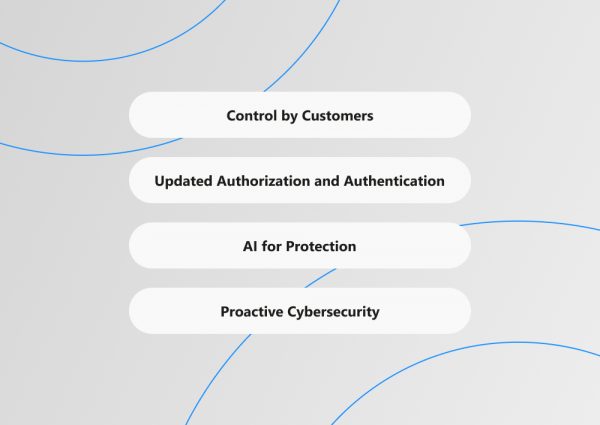What were bank-customer relations like? Usually, people were introduced into the concept of the bank in their teenage years and stayed with the preferable banking institution all their life. That was standard practice for decades. In 2013, the European Commission proposed the PSD2 (the Payment Services Directive), and open banking development began. The directive obliged EU payment service providers to allow open access to customers' account data. That meant that customers did not "belong" to banks anymore.
Our professional overview will highlight open banking and its development in different parts of the world, its advantages and pitfalls for all parties involved, and the main prospects.
WRITTEN BY:
Alexander Arabey
Director of Business Development, Qulix Systems
Contents
Open Banking Definition
According to Statista, in 2020, there were 24.7 million users of open banking services, and by 2024 that number is expected to reach 132.2 million worldwide. The leader of open banking is Europe — about 12.2 users there chose these solutions in 2020. By 2024, 63.8 million Europeans will turn to open banking.
Then, what is open banking? The term "open banking" stands for the regulated system for banks when they open their API (application programming interfaces) and allow TPPs (third-party providers) to selectively access customers' financial data and distribute new services, apps, and solutions.
Why did it become necessary to establish open banking standards?
Open Banking — Timely Solution
Before open banking technology, banks had a monopoly on the financial data of their clients. However, they could only rely on their client database — people and businesses attracted to banks by ad campaigns, negotiations, or special offers. That base was strictly limited and was not a competitor to modern mobile service providers, online retailers, and social network opportunities. Furthermore, traditional financial institutions faced severe competition from fintech companies which were at the forefront of technological innovations in the sphere and had the best specialists in research and development.
No wonder that the global economy needed something more potent than a brick-and-mortar banking system. And the fuel for this update is API implementation and open banking. So what are the technological advantages of this solution after all?
API vs. Screen Scraping
Let us take for example third-party PFM (personal financial management) apps or account aggregators. Their first generation required entering the same name and password as for your bank account. The updated versions could screen scrape — they chose the necessary data from your device screen, thus getting access to all your account data. No wonder that both methods were highly unsafe and unreliable.
On the contrary, an API allows TPPs to access financial information securely and efficiently. In contrast to screen scraping, the API only gives access to the needed data without revealing sensitive data and passwords. So, PFM tools can selectively use your bank account balance details and specific transaction data for further analysis to provide recommendations on effective spending track and budgeting.
The main goal of API and open banking implementation is to improve financial services for customers and provide consumer-permissioned control of their financial data. Very promising, isn't it? Yet, the adoption of open banking is not on the same level over the world.
Open Banking Initiatives: Global Outlook
As we have already mentioned, the European financial system is at the front line of open banking. It is explained by the authorities' particular interest in providing clear standard regulations for financial institutions across the continent. Let us see where some national open banking systems in Europe and other parts of the world are now.
The EU — PSD2, administered by the European Commission, obliges payment service providers to harmonize consumer protection in the integrated payment market of the continent. The directive is a regulated framework for all financial institutions.
The UK — the Open Banking law (the British version of PSD2), issued in 2018, forced the country's nine biggest banks to release financial data in a standardized, secure form for easy sharing among authorized organizations online. Now, more than 200 financial service providers are enrolled in Open Banking.
The USA — unlike Europe, open banking in the US made a late start, but now the common strategy is being developed by the largest American and Canadian banks. In 2018, the American Treasury Department published a report on financial services where it determined further open banking innovations.
Latin America — the region's countries are implementing open banking extremely fast but unevenly across the continent. The leaders of innovations here are Mexico and Brazil.
Russia — the regulator, the Central Bank of Russia, published a standard for open banking interfaces (open APIs) in July 2021. It defined the method and the format of data exchange for the banking industry and fintech companies.
Asia — the regulatory bodies within the region have different recognition of open banking platforms. The leading countries are Singapore, Hong Kong, and Australia, which established standards for banks to share their customers' data with third parties.
The Security of Open Banking Explained
Is it safe for all parties involved to implement open banking? It is time to uncover this answer as it is one of the most significant concerns about this technology.
Open banking provides the highest level of security and scalability for financial services thanks to APIs. There are several necessary improvements that open banking brings to the banking industry.
Control by Customers
One of the main strong points of open banking is its transparency. Consumers get more control of their data and of the ways financial institutions use it. Players in the financial market are required by the regulators to inform their customers about everything. Businesses and individuals can see what their data is used for and control it. In Europe, for example, it is provided by the GDPR (General Data Protection Regulation) and applies to any enterprise in the EEA.
Updated Authorization and Authentication
One more layer for customer control that open banking provides is the regulator's confirmation that the apps and services requesting information are trustworthy. Previously, you had to agree to the terms and conditions of the subsequent usage of your data. That meant you were supposed to read the legal agreement and tick a corresponding box. But did you bother reading all those documents?
For instance, this vital task is now overtaken by regulatory authorities: the Financial Conduct Authority (FCA) in the UK. Also, these regulatory bodies empower customers to check the authenticity of any financial institution requesting their data.
Furthermore, customers need to be confident that they are the only ones to share their financial data. The next layer of confidence is provided by multifactor authentication required by the SCA (Strong Customer Authentication) law in the EEA. According to this document, to proceed with the payment, the customer will have to pass at least two of the following stages:
- Something you are — biometric data (i.e., fingerprint or voice patterns);
- Something you know — identification info (i.e., a password or PIN);
- Something you own — a device for identification (i.e., a smartphone or a token)
AI for Protection
At the same time, the modern financial service system faces the challenge of preventing money laundering and illegal activity. KYC (know your customer) check initiates the process controls, and it is enabled by close collaboration with partnering organizations to help each other monitor any suspicious activity.
Here, open banking provides a broad standardized database for implementing AI to enhance the process of monitoring and marking anything unusual and thus suspicious. It also leads to more secure and robust banking services for depositors and businesses. Ultimately, open banking and AI make the banking sector much safer for all parties involved.
Proactive Cybersecurity
Moreover, cross-industry standards in cybersecurity move the protection of customers to the next level. Information sharing and collaboration in the banking industry promote the development of automated thread response algorithms. Which, in its turn, leads to more advanced proactive threat-detection systems that hunt for all types of vulnerabilities and search for any kinds of fraud and cyber-attacks because it is better to prevent problems than fight them.
What Is Open Banking: Win-Win Story
As you see, the open banking concept has enormous potential to entirely transform the financial situation in the world. Being a new technology, the solution has a certain amount of uncertainties and risks. All of them are connected with security and even physiological concerns about data sharing (remember the rule about keeping your data away from other people's access). But, as we mentioned earlier, it makes a strong contrast to the core idea of open banking technology — providing robust standards and giving more awareness to clients.
Let us name some more benefits that open banking creates.
Banks Upgraded
The competition with TPPs will encourage banks to develop new services and tools for their clients. And, what is even more critical, it will break the deadlock in providing more competitive pricing.
Helpful Tools Introduced
App developers will launch new technological solutions and financial products built with AI and more advanced tech. For example, PFM tools with AI will help you predict events or suggest new products to save money or investments.
Lending Advanced
It will become easier to get or refinance a loan. Open banking will empower lenders with the permission to grab needed information and make adequately supported decisions. There will be no need to prepare all the documents manually, either for individuals or businesses.
Accounting Automated
An accounting banking app will ease and lower the price of the process. It will automatically update after you receive or send a payment. And it will perform all tax-preparation tasks.
Payment Methods Developed
One of the most significant parts of open banking regulations across the world deals with payments. It empowers additional service providers with cheaper and effective payment methods, which will be beneficial both for businesses and their clients.
Summing It Up
The future is encouraging for the financial ecosystem. We believe that financial services will be customized and amplified significantly to meet more customers' needs. With open banking, APIs, and implementing AI, ML, and other technologies, the finance ecosystem will be transformed into an end-to-end customer-centric offering.
To learn more about our competencies in fintech and banking solutions, contact our specialists. And keep up with our exciting blog for more insights.

Contacts
Feel free to get in touch with us! Use this contact form for an ASAP response.
Call us at +44 151 528 8015
E-mail us at request@qulix.com












